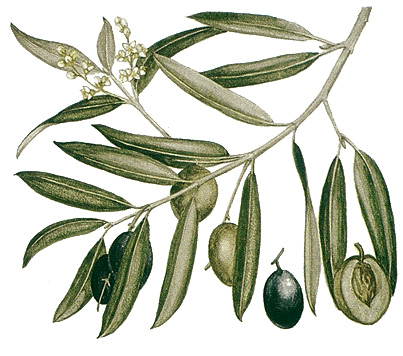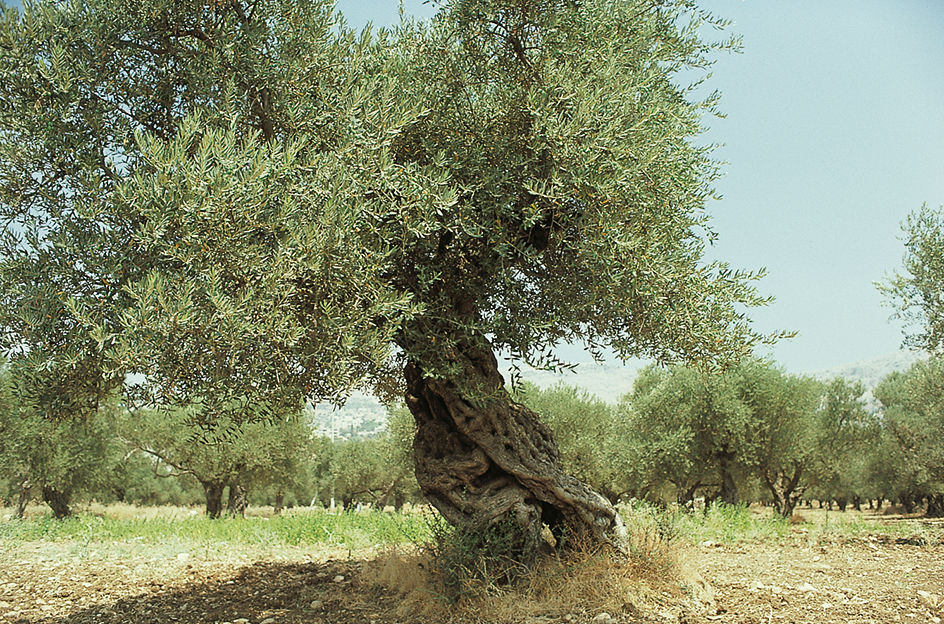Olive is the fruit of a tree that is native to the Mediterranean region. Olives are cultivated both for their oil and for the fruit itself. People have grown olives since prehistoric times. Olive trees first grew in the eastern Mediterranean basin. Centuries ago, they began to grow wild around the Mediterranean Sea. The Spaniards brought olive trees to South America, and they were introduced into California in 1769. More recently, they have been introduced to Australia.

Appearance of the fruit and tree.
The fruit may be oval or oblong. As it matures, it turns from green to yellow to red to purple-black. It has a smooth skin, and its flesh surrounds a hard pit. Both the flesh and the seed in the pit contain oil, which makes up 10 to 40 percent of the mature fresh fruit’s weight. Fresh olives contain oleuropein, a bitter substance that makes them unpleasant to eat before processing. During processing, this substance is largely or entirely removed.
The olive tree’s bark and leaves are a soft gray-green, and its trunk becomes gnarled as it ages. Olive trees live longer than most other fruit trees. There are olive trees in the Middle East that may be more than 2,000 years old.

A mature olive tree may have as many as 500,000 small flowers. Most of the flowers are imperfect, and fruit cannot grow from them. They give off pollen, which is usually carried from flower to flower by the wind. Most varieties of olive trees bear a large crop one season and a small crop the next.
Cultivation.
Parts cut off from an olive tree may take root and grow into new trees. The trees will grow in many types of soil but need good drainage. To produce large fruit, the grower must irrigate and prune the trees. Fertilizers that add nitrogen to the soil can increase yields. The olive tree grows best where the climate is hot and dry. But for bearing good fruit, the tree needs a moderate supply of water. The fruit matures from October to January and is injured if the temperature falls below 26 °F (-3 °C). The tree itself is not seriously injured until the temperature falls to 16 °F (-9 °C). The fruit needs much heat to have a good quality when mature. The air must be dry when the flowers blossom, and also when the fruit begins to grow.
Harvesting and preparation for market.
Most olive-producing nations grow the fruit primarily for its oil. Until the early 2000’s, nearly all olives grown in the United States were processed to be eaten. Now, more olives are processed for oil than are processed to be eaten.
Harvesting olives requires careful handling. Olives grown for their oil may be mechanically harvested. Olives grown for eating have traditionally been picked by hand to reduce damage to the fruit.
Olives are harvested later than other fruit crops, in the fall and winter. Generally, olives that are harvested later accumulate more oil and have milder flavors.
Olives processed for eating are either green or black. One of three major processing methods may be used: (1) the Spanish, (2) the American, and (3) the Greek.
Most green olives are prepared by the Spanish process. In this process, unripe, yellowish-green olives are placed in a solution of sodium hydroxide (also called lye). The sodium hydroxide removes most of the bitter taste of the oleuropein. The olives are washed and then fermented in brine. They are kept submerged continuously to prevent darkening, which can result from exposure to the air. The fermented olives may be pitted and stuffed with such fillings as almonds and pimentos. The fruit is then packed in fresh brine and pasteurized.
In the United States, most black olives are prepared by the American process. This process ripens immature, yellow-to-red olives artificially. The fruit is alternately submerged in sodium hydroxide and exposed to the air until no bitterness remains and the olives have turned brown to black. The fruit is then washed and pickled. After canning, the olives are sterilized at 240 °F (116 °C).
In the Greek process, ripe, purple-black olives undergo a slow fermentation in brine. During fermentation, the fruit’s bitterness decreases. This process traditionally does not use sodium hydroxide.
Production.
Nations along the Mediterranean Sea grow most of the world’s olives. Spain is the largest olive producer. Other leading producers include Greece, Italy, Morocco, and Turkey. World olive production totals about 23 million tons (21 million metric tons) yearly.
The United States olive crop comes almost entirely from California. California is the only part of the country that has a Mediterranean climate. Olive trees also grow along the Gulf of Mexico but do not bear fruit there.
